Buy Online
- Package Deals
- Extreme Security Chain and Lock Deals
- High Security Chain and Lock Deals
- Medium Security Chain and Lock Deals
- Security Chain and Multiple Lock Deals
- Shed Shackle, Protector Chain and Lock Deals
- Door Security Package Deals
- Ground Anchors
- Chains (without padlocks)
- Shed Shackle
- Padlocks
- Anti-Pinch Pin
- Door Security
- Extras and Upgrades
- Fitting Kits
- Hardware, Fixings, Drills
- Chain Offcuts & Sleeves
- Alvecote Wood Related
Your Cart
Information
Roller Shutter Door Security: Lock 'n' Roller
Roller shutter doors are commonplace on commercial buildings, but their security is very often lacking, leading to easy pickings for a thief. Since these buildings are often on isolated industrial parks, etc, the thief can often work undisturbed while helping himself to valuable items, and an open roller shutter door makes it easy to load property in bulk. Roller shutter doors give quite good security, but only if they are locked closed! If a roller shutter door can be easily opened, either from the inside or by levering from the outside, they are good news for the thief and bad news for you!
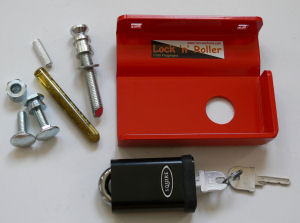 The Lock 'n' Roller is an innovative, visible, and proven effective deterrent that locks both sides of the bottom of the door itself so the thief can see it's not an easy target.
The Lock 'n' Roller is an innovative, visible, and proven effective deterrent that locks both sides of the bottom of the door itself so the thief can see it's not an easy target.
The photo to the right shows the contents of the fitting kit for a single side only. The Lock 'n' Roller is normally fitted as a keyed-alike pair, so you have two sets of locking bracket, lock, and all fixings. The locks being keyed-alike means they are both worked with a single key - saving you fiddling around when you want to get on with your work!
Unlike other products that require large holes in the concrete, or that only provide poor security (and often invisible security) on the inside of the guide rails, the Lock 'n' Roller utilises a high grade (CEN 4) Squire HLS50S padlock with a 6-pin cylinder (the same as the highly respected SS65CS and SS50CS locks - it can be keyed-alike to those locks, in fact).
The Lock 'n' Roller is easy to fit to most roller shutter doors and is brightly coloured to make it obvious that the thief has got his work cut out.
Why a Roller Shutter Door Security Product?
We at Pragmasis developed the Lock 'n' Roller because we own a building previously attacked by thieves, at a vulnerable and isolated site. The thieves gained entry to the building in the past and it was then easy for them to open the roller shutter with the manual chain on the inside. They then had an easy way in and out of the building, carrying whatever they liked. (Fortunately, we do security and everything inside was heavily secured with our Protector chains, ground anchors, etc etc, so they stole nothing. Indeed, there is nothing in that building that is worth them stealing, but their attack did cause significant damage and we wanted to keep them out of the buliding in future.) We looked around at everything available on the market and found nothing that gave decent security, was reasonably easy to install, and that was visible as a serious deterrent from the outside of the building. So we designed our own product which has been in use, in anger, for about a year before we launched it as a product in our range.
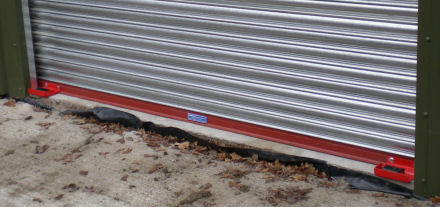 The photo here shows a pair of Lock 'n' Roller brackets fitted to the roller shutter door on that building. The door itself is now locked closed (independent of any locking arrangement on the chain and rails) and the thieves can see that they don't have an easy way in or out any more. This was tested, so to speak, when thieves tried a repeat attack after the Lock 'n' Roller was fitted. They did not gain entry and the Lock 'n' Roller did its job perfectly. We could see that they tried to defeat it with a levering attack under one of the locking plates, but that failed as a result of the chemical resin giving such a good fixing.
The photo here shows a pair of Lock 'n' Roller brackets fitted to the roller shutter door on that building. The door itself is now locked closed (independent of any locking arrangement on the chain and rails) and the thieves can see that they don't have an easy way in or out any more. This was tested, so to speak, when thieves tried a repeat attack after the Lock 'n' Roller was fitted. They did not gain entry and the Lock 'n' Roller did its job perfectly. We could see that they tried to defeat it with a levering attack under one of the locking plates, but that failed as a result of the chemical resin giving such a good fixing.
Chemical resin capsules are much stronger than old-fashioned expanding bolts/'Rawlbolts'. Resin capsules are used by Rolls Royce for testing jet engines as well as innumerable safety-related applications on bridges etc etc. We've had excellent results with them for many years in our top-rated Torc Ground Anchor concrete floor fitting kit (the only anchor fitting on the market with Sold Secure Gold accreditation in every category).
Even though the concrete slab on this building is narrower than it should be - the locking bolts are closer to the edge of the concrete than we'd recommend - they still did the job and the product paid for itself immediately in terms of damage that was likely averted.
Lock 'n' Roller Design Details and Fitting Requirements
Constructed out of heavy duty laser-cut, folded and welded steel plate, the Lock 'n' Roller locking plate is finished with a zinc phosphate pretreatment under the powder coating, to give maximum protection against the weather.
The drilling is kept to a minimum as a result of the high grade chemical resin capsule only needing a 14mm diameter hole in the concrete and a suitable masonry drill bit is included in the kit (an SDS-Plus drill bit is available as an option).
The locking plate gives good protection to the Squire padlock as a result of it being sided - i.e. the plate fitted to the left side of the door is a mirror image of the plate fitted to the right side of the door.
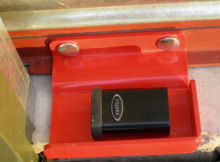 The frame of the door itself protects the lock from the outer side, whilst allowing sufficient space to fit the key into the lock! The padlock itself gives excellent protection to the main locking bolt as a result of the lock body having no cut-out on the top face - the shackle and the top of the locking bolt are competely inaccessible from above.
The frame of the door itself protects the lock from the outer side, whilst allowing sufficient space to fit the key into the lock! The padlock itself gives excellent protection to the main locking bolt as a result of the lock body having no cut-out on the top face - the shackle and the top of the locking bolt are competely inaccessible from above.
The photo to the right is a close-up of the Lock 'n' Roller locked in place with the roller shutter door closed. The padlock is locked onto the locking bolt. (Left side plate shown - the door frame is just visible to the left).
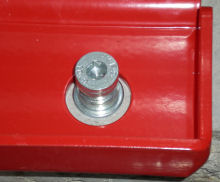
The photo to the right here shows a close-up of the top of the installed locking bolt before the assembly is locked together with the padlock. The locking plate is lowered as a result of the roller shutter door being closed. The locking pin presents minimal trip hazard when the door is open as a result of it being so close to the side of the doorway.
The locking bolt is held firmly in the concrete with the chemical resin, and a specially machined collar, under the bolt head (more visible in the kit contents photo at the top of this page), fits closely to the underside of the Squire padlock.
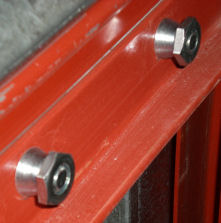
This photo shows the shear nuts that are used on the inside of the door to secure the locking plate. Note: This shows the shear nuts before the hexagonal heads are sheared off! Once they have been sheared off, which is easy to do by hand, the conical section that remains provides an effective anti-tamper fixing on the inside of the door. Even if a thief gains entry to the building, it is still difficult for him to defeat the Lock 'n' Roller. We've been using shear nuts very successfully for many years with our Shed Shackle product - they are easy for you but bad news for the thief!
2 keys are provided with each lock - a keyed-alike pair has a total of 4 keys.
We are proud that the Lock 'n' Roller is made in Britain.
Lock 'n' Roller Suitability and Dimensions
Note: The Lock 'n' Roller is not suitable for fitting on tarmac! Tarmac does not give adequate strength or protection for the locking bolt.
Note also: Roller doors with rubber seals are also not suitable as the metalwork at the bottom of the door is offset too far upwards when the door is in its closed position (see below for more explanation). Larger industrial doors often have these rubber seals and we are unable to accommodate those satisfactorily with this design.
The concrete should be at least 4" (100mm) thick. It should extend at least 120mm in front of the door, ideally. The locking bolt is fitted approximately 85mm in front of the slats of the door.
Locking plate dimensions: 155mm wide x 120mm deep (in front of the door) x 30mm high (approx.)
The locking plate has a 5mm 'jog' to clear the thickness of steel angle that is normally fitted to the bottom of the door. This jog is approximately 50mm from the front face of the angle, so the angle itself should not be more than 5mm thick or raised above the floor (e.g. by a rubber seal) or more than ~40mm wide (in front of the vertical face where the locking plate fixes).
If the bottom of your door appears incompatible with these details, please contact us and we will see if we can help.
How Easy is it to fit a Lock 'n' Roller?
The fitting kit includes all parts that are required. The only tools you will require are:
- An electric hammer drill (variable speed recommended)
- HSS (metal cutting) drill bits 11mm and 4mm (as a pilot), to suit drill
- 6mm (or similar) masonry drill bit (as a pilot), to suit drill
- A 19mm AF spanner or adjustable wrench
- A medium sized hammer
- A centre punch for locating the drill bit
- Eye protection – goggles or a visor should be worn
- A pencil or felt pen or similar for marking holes to drill
It takes approximately 60 minutes to fit. It is designed to be suitable for a DIY fit, so any maintenance or building services worker should find it easy.
Design Improvements
We have upgraded the Lock 'n' Roller security product for roller shutter doors with several design improvements, as follows:
- The locking plates are now hardened;
- The machined collars are now hardened and dimensions have been adjusted to improve compatibility with the latest Squire locks;
- The circular opening in the locking plate has been enlarged to improve ease of use, especially on doors that float significantly side-to-side;
- The coach bolts are now high-tensile and the bolt heads are recessed (counterbored) into the locking plates, to deter chiselling attacks.
Pricing remains unchanged, for now.
Updated photographs will be available in due course.
Availability and Ordering
The Lock 'n' Roller can be ordered online.
